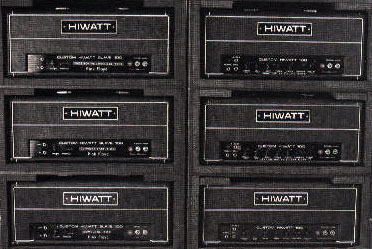


GILMOUR, GUITARS & GEAR
Gilmour, Guitars & Gear
by Richard Mahon
 In
this column, I'll be examining Pink Floyd guitarist David Gilmour's gear and
playing techniques from a musician's point of view. Please feel free to e-mail
me with questions and ideas for future articles at RichM66@Compuserve.com
if you feel you have an idea that readers of Spare Bricks might find
of interest. Past articles are now posted at - http://richardmahon.8m.com/sbarchive.htm.
In
this column, I'll be examining Pink Floyd guitarist David Gilmour's gear and
playing techniques from a musician's point of view. Please feel free to e-mail
me with questions and ideas for future articles at RichM66@Compuserve.com
if you feel you have an idea that readers of Spare Bricks might find
of interest. Past articles are now posted at - http://richardmahon.8m.com/sbarchive.htm.
Hiwatt amplifiers
Dave Reeves produced the first Hiwatt amplifiers in early 1966 before he became a part of Hylight Electronics. He joined forces with Harry Joyce who specialized in "point to point" wiring of amplifiers to "military specifications." Amps would be hand wired from each component to another as opposed to the PC circuit boards that are more common today. Specialists who worked in the British Military wired these amplifiers with strict attention to detail.
 Hiwatt
amps were constructed unlike other amps at the time. While many amp companies
were building gain-oriented amps, that would overdrive as the gain and volume
were raised, Hiwatts were bright and incredibly clean. Any distortion would
have to come from an effect pedal. The Hiwatt amp company originally catered
to touring musicians who were interested in Hiwatt's versatile tone characteristics
and rugged construction. One such band was Pink Floyd in 1969.
Hiwatt
amps were constructed unlike other amps at the time. While many amp companies
were building gain-oriented amps, that would overdrive as the gain and volume
were raised, Hiwatts were bright and incredibly clean. Any distortion would
have to come from an effect pedal. The Hiwatt amp company originally catered
to touring musicians who were interested in Hiwatt's versatile tone characteristics
and rugged construction. One such band was Pink Floyd in 1969.
From the beginning, Gilmour preferred Hiwatt's 100-watt amps. The model number for a Custom Hiwatt 100 is called the DR103. The earliest video footage of David Gilmour with a Hiwatt amplifier is found during the KQED PBS-TV studio taping in San Francisco on April 29, 1970.
The first part of the Hiwatt serial number begins with an "AP." This stands for "all-purpose." A Hiwatt head can be a guitar amp head, a bass amp head or a PA system. The perfect example is Pink Floyd's 1972 film release Live At Pompeii, which somewhat resembles a 90-minute advertisement for Hiwatt amplifiers. Gilmour used three heads on his side of the setup (two for the performance, one as a backup.) This would become his standard setup. Rick Wright had three Hiwatts stacked to amplify his keyboards and Roger Waters used a Hiwatt as his bass head in the footage filmed at Abbey Road Studios.
By 1974, Gilmour was touring with 10 interchangeable Hiwatt heads. He favored certain heads over others. The roadies couldn't tell the differences, but he could. A roadie from that time period mentioned that he would set up the amps and Gilmour would ask for one of the heads to be replaced. The roadie would take the amp, walk around in a circle behind the back of the stage and bring it back figuring Gilmour would never know the difference. The road crew would soon learn that Gilmour's ear for tone made him the envy of the most experienced members of the sound crew.
 At
that point in time, Gilmour's three Hiwatt heads were powering two 12" monitors
in front of him and four 4 X 12-inch speaker cabinets behind him.
At
that point in time, Gilmour's three Hiwatt heads were powering two 12" monitors
in front of him and four 4 X 12-inch speaker cabinets behind him.
After the end of the 1974 tour, Gilmour had his amps modified. Two of the four inputs (two Normal and two Brilliant) were soldered together into a single input that combined the characteristics of both inputs.
Hiwatt amps were used for each of the tours that followed - the 1975 tour, the 1977 Animals tour, the 1980-81 live performances of The Wall, and the 1987-89 tours for A Momentary Lapse Of Reason. His solo tour for About Face in 1984 was the exception. It was the first and only time, since 1969, that Gilmour performed a major tour without Hiwatt amplifiers.
In 1992-94 sessions for The Division Bell, Gilmour used a pair of Hiwatt 50 watt combo amps, known as the SA212 series.
Before the 1994 tour, Pete Cornish separated the pre-amp section of the amps from the power amp sections. Gilmour's tone controls were disabled, leaving only the Presence and Volume to control his amps. The Hiwatts with these modifications work much like a slave amplifier.
 On
the 1994 tour Gilmour used his standard three Hiwatts but added three Hiwatt
STA 100 slave amps to power his Heil Voice Box and Doppola rotating speakers.
Hiwatt slave amplifiers have only two controls - Presence and Volume.
On
the 1994 tour Gilmour used his standard three Hiwatts but added three Hiwatt
STA 100 slave amps to power his Heil Voice Box and Doppola rotating speakers.
Hiwatt slave amplifiers have only two controls - Presence and Volume.
Subsequently, Gilmour's EQ was controlled by the SPC (mid-range boost) and EXG (hi & low range boost) in the EMG pickup setup on his guitar. He no longer used conventional settings for Bass, Middle and Treble on his Hiwatt amplifiers.
Richard Mahon is a staff writer for Spare Bricks.